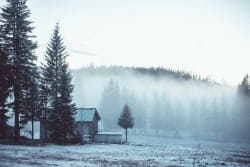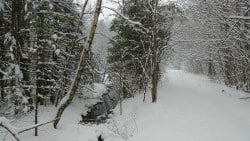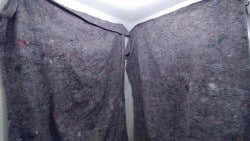Well, we’ve found that Christmas has passed, and here we are again, stuck smack dab in the middle of yet another
Under normal everyday circumstances, winter sucks for most people once the thrill of Christmas and the winter holidays has passed. Even with the modern conveniences of running furnaces, humming pellet stoves, and hot water generally any time one wants, winter still isn’t much fun if you’re not a winter sports (skiing/snowboarding, snowshoeing, snowmobiling, ice fishing, etc) person. If you have blood circulation issues (such as Reynaud’s Disease) or other health problems, weather can be downright dreadful and flat-out miserable, if not deadly. As I write this, the Northeast US has been slammed by a severe cold spell, with temps dipping to -20°F and lower – and my wife’s feet have been ICE every time she crawls into bed with me. Tragic, I know.
Also Read: Cold Weather Survival in a Blizzard
But what happens if we lose these wonderful modern conveniences because of a SHTF event? If the power grid
Since it’s been more in-my-face than usual this year due to the bitter cold temperatures, I’ve been considering priorities and taking actions to help prepare my family for a power-out Maine winter – here are some of my musings.
SKIP AHEAD
Keep it Warm (duh)
When temps drop below freezing for any length of time your immediate priority is no longer food and water – the sheer cold will kill you faster than dehydration. Therefore, we need to prioritize warmth in your shelter above all else. As I will likely be staying put in any major SHTF event that’s not locally threatening, I need to first evaluate my home for its ability to produce heat with appliances, as well as retain said heat.
My personal house was built in the 1920s, with all the innate charm and lack of insulation and efficiencies that vintage houses offer. My built-in heating appliances are a well-maintained oil-burning furnace and a pellet stove. While both of these methods are great while the power is running or generator is producing, I’m SOL once the juice goes bye-bye. I know that heat is a major shortcoming in the plans, so I need to look at maybe trading the pellet stove in for a small-to-medium-sized wood stove to mount in its place. If a full-sized wood stove isn’t practical or if you live in apartment building, perhaps a smaller wood stove like the Tiny Wood Stove Dwarf or perhaps a propane burning stove may work for a smaller house or apartment. However, consideration needs to be taken to properly vent the exhaust fumes – carbon monoxide will kill you just as dead as the cold or dehydration. If you’re creative, you could probably work up an insulated panel with a hole in it to run a small chimney through a window to keep the warm in and the fumes and smoke out.
Related: M1951 Fishtail Parka
Wood stoves have the advantage of running off a locally-obtained fuel source. They can also produce heat off paper, some types of trash, and even cloth or busted-up furniture if the desperation level is high enough. Versatility is a major selling point for a good wood stove. A wood-burning fireplace works if you have one in your house, but just be aware that most of your heat (something like 70%, I’m told) actually goes out your chimney instead of radiating out to your living space, and as such, it is vastly inefficient. A better bet is to have a wood stove installed in your fireplace cavity – my brother did this in his 1820’s Maine farmhouse, and it works brilliantly.
Kerosene or other fuel-fired heaters are also available for inside applications, but care still needs to be taken to allow proper ventilation. Open flames (even ones somewhat contained inside heaters) still need to be carefully monitored as well. Nobody wants to be the victim of irony when you burn to death while it’s freezing outside.
First aid kits are an absolute must in general, but be sure to keep one around heaters. Train your family not only to avoid burns, but to know how to recognize levels of severity and treat burns as well. A couple years ago, my son lost his balance while running around near the running pellet stove, and just a quick brush with the glass-faced door severely burned my boy’s hand. I was able to diagnose that the burns weren’t severe, and treat them at home with first aid supplies and cool water. During a SHTF event, anything that can go wrong will, and likely with harsher consequences since professional medical attention probably isn’t readily available. Perish the thought, but what if the grid was down, and my son had put his whole arm through the glass door, getting cut AND burned? Vigilance and knowledge will keep you in good shape when having to deal with interior heating. Stove guards and/or screens – readily available at any heating shop or big box store – are a great idea, and inexpensive insurance.
I also have plenty of super-cheap wool disaster blankets and thermal curtains to hang over doorways and windows
Obviously, lots of warm clothing and blankets are needed to keep the required temps down so fuel expenditures can be kept to a minimum. Winters can last a long time – make your fuel last. If feasible, during sunny days, pull blankets down off south-facing windows (if you’re in the northern hemisphere) to take advantage of the solar heat gain provided by the sun shining directly into windows. The vitamin D production from sunlight, and the morale boost from natural daylighting can be a huge help.
Keep it Dry When You Go Out
Dry clothing is a game-changer in winter. Yes, the shelter and heat is nice, but when you’re outdoors, wet clothing quickly sucks the heat right out of your body, whether you like it or not. Sweat can be a wetness-inducing culprit if you’re working hard, but in winter, snow and ice on your clothing and melting from your body heat can make you miserable and practically drenched in very little time. Temps slightly above freezing are the worst (in my opinion), because snow on tree branches, foliage, rooftops – it melts, gets heavy, and succumbs to gravity. And in my experience, that gravity seems to guide it right down my damn neck. Snow turns slushy, and your boots will soak through, up your pant legs. In no time at all, much of your body can become wet – and low temps, combined with wet clothing, is a killer.
You Should Also Read: Weather Preparedness
Solution? Wear wool when possible. Wool insulates while wet and can help keep you warm enough to get back to your fire and dry out. Hybrid moisture-wicking undergarments can keep moisture collection caused your sweating under control if there’s no snow. Knee-high insulated rubber boots (like those made by Muck or LaCrosse) are expensive, but will keep your feet dry in the wettest of conditions. Gaiters are fantastic in the snow, and waxed canvas jackets can help repel water. Carry spares of socks, gloves, long underwear if you’re outdoors for an extended period of time – these items will get wet the fastest and can make you miserable the fastest as well. Many outdoors-oriented companies offer waterproof or rainproof clothing – but just be mindful that while they often keep water OUT, they also keep water IN by not allowing your body to breathe – so sweat or other moisture in your clothes generally stays there until you can get your clothes off to dry them out.
For the kids, sweat usually isn’t as much of an issue, so make sure they have high quality outdoors clothing that will help keep them from getting wet. Snow pants, long winter jackets, and rubber insulated boots are a must. My mother used to put plastic bread bags over our feet to keep our piggies dry – and it works, very well. So if you have to go outdoors with the kids during a winter SHTF event for whatever reason, make sure they are dressed well for the weather, and keep an eye on them! Children don’t know the warning signs of hypothermia and other cold-induced maladies, and often will not recognize that there’s an issue. Stock up on hats and gloves, even handwarmers – you’ll need ‘em! Dry kids are happy kids, and they’ll be amazingly resilient as long as they’re warm and dry, and see Mommy and/or Daddy positive and happy.
When drying your clothes indoor by your heat source, remember that just because the clothes are wet, it doesn’t mean they can’t catch fire. I’ll admit to losing a couple pairs of really great boots and some expensive wool gloves by having them too close to a fire to dry out. Same can happen to your other clothing as well – get a drying rack, keep it far enough away so that sparks or ambient heat won’t catch or melt your valuable outdoors gear. As a bonus, water evaporating as steam from wet clothes can help keep a little moisture in the shelter’s air and keep you from being miserably dry.
Make sure you have the tools for moving efficiently and quickly in the snow – high quality snowshoes, cross country skis, sleds, and even snowmobiles will help minimize your time in the cold by helping you get where you need to go more quickly.
Watch Your Provisions
If you’re going with keeping just a room or two warm and blocking off the rest of the house, you’ll probably want to bring some water reserves and any food containing water into the room with you. It would be a heartbreaker to head to your cold pantry to find your carefully stocked canned goods or water jugs have burst from freezing.
Water can be kept inside coolers to prevent freezing for periods of time, high-end coolers like what Yeti offers will suddenly be worth their weight in gold if the temps are below freezing and your survival water starts getting slushy.
Keep Your ‘Dirty Business” Separate and Clean
Going to the bathroom could be a positively miserable experience when the power is out and you’re snowed in.
When I was maybe 5 or 6 years old, my father rented a ramshackle house with no power (that I remember) during a very cold New England winter, near a factory he was getting up and running. We didn’t have much money, which meant that he did the warm-room technique, with blankets and plastic sheeting over doorways, and a kerosene heater to keep us warm. We all stayed in one room. It wasn’t extravagant, but we were together.
What I DO clearly remember is the bathroom consisted of a 5-gallon bucket in the next room, with a trash bag liner and a liberated toilet seat perched on top. The world’s coldest craps ever recorded happened inside that sad little bathroom, and about the best thing that could be said about it is that there weren’t any flies – it was too cold. But we bit the bullet and did what we had to do. When the fun was over and the bag filled to a reasonable level (solid waste only – no peeing in the bag!) we tied it up and brought it outside to a dumpster. All urinating was done in another bucket, which was dumped outside a safe ways from the house. Glamorous as all hell, right? But it served the purpose, gave us privacy and fullfilled our needs, and we got through.
A similar setup could be run in a SHTF house with limited warmth. Bring the toilet seat with you in the warm room with you – nobody likes cold toilet seats. Leave the waste bucket elsewhere, preferably in a room where you can close the door and keep scents out of the common area. Survival food isn’t always that friendly on the gastrointestinal system – you all know what I mean. Of course, if you can bear doing your duties outdoors, do so when practical.
Stock toilet paper, trash bags, and paper towels. Keep jugs of hand sanitizer available to minimize water usage and keep hands and other areas clean. Have lotion on hand as well – hand sanitizer will dry your hands out quickly, and the cold temperatures will exacerbate that. Cracked hands will ruin your day quickly; lotion or petroleum jelly will keep them up and running. Petroleum jelly can also be used for cold-chapped lips or to start fires.
Keep it Fun
Cabin fever sucks enough when you have easy heat and power. It sucks FAR worse when your family, who is used
Related: Cold Weather Camping
Keep everyone engaged with everyone – maintain a team atmosphere and don’t leave any family members out of activities unless requested to do so. Keep minds occupied, sharp, and challenged – a dull mind will drift to dwell and fester on the misery. A team having fun and facing challenges together will also keep from harboring resentment or creating arguments amongst fellow dwellers. When you’re shut in a room with your family for an entire winter with everyone trying to stay warm and survive, every little bit of friendliness, fun, and love will count.
Keep Yourselves Illuminated
Light is also essential to combat your situation; the darkness outside is present for a much longer period of time during the winter and the dark will be (not can be…WILL be) overwhelming and depressing. Solar-powered lanterns like the Hybridlight PUC or PSL Personal Solar Lantern will be godsends and just one will light up a decent-sized room with aplomb for hours on a single charge. Solar-powered flashlights like the Hybridlight Journey series will be extremely useful as well, and not require stockpiles of batteries while being able to charge devices via USB ports.
Open flames (especially in old houses like mine) can lead to serious combusting problems if kids are running around, so where possible, keep candles and oil-powered hurricane lantern use minimized. Keep flames elevated on wall sconces or on shelves to minimize risk of tipping over. Definitely keep flames well away from ANYTHING flammable – even bacon grease or household cooking oils.
Don’t Give Up, HAVE A PLAN!
Look, you’re in the middle of a SHTF event. Life is gonna suck enough as-is, even without having to shelter in place in the middle of winter and fighting to beat the cold. Knowing you’re very possibly going to have to face a disaster in this most inhospitable climate and having a plan will go a long way towards keeping your morale up and your mind focused on the task at hand – keeping your family alive.
Even if you don’t live in an area that resembles the surface of Hoth in winter, you should still have an active plan in place to deal with harsher temps and the effects they have on men, material, and shelter. Have a plan in place, and if possible, incorporate your neighbors or your SHTF team to corroborate and share resources – for example: you may not have a Coleman Stove for cooking, but you might have firewood in your basement that’s cut to length to fit your neighbor’s wood stove. Maybe your friend’s stocked pantry can be used to stock food for two families, and other deals can be made for your weapons cache to be distributed for security.
Also Read: Cold Weather Shelter Practice
Once the chips are down and we’re in the middle of knee-deep snow and subzero temps, your plans, thoughtful predetermined actions, and your family will probably be all you have. Start now while you have that reliable furnace and think, “what would I do if that died RIGHT NOW?” Build from there. It may mean the difference between life and death when your life is on the line.
Of course, this dissertation doesn’t cover everything to be considered. What else would you add for your winter SHTF planning? Sound off in the comments below!







